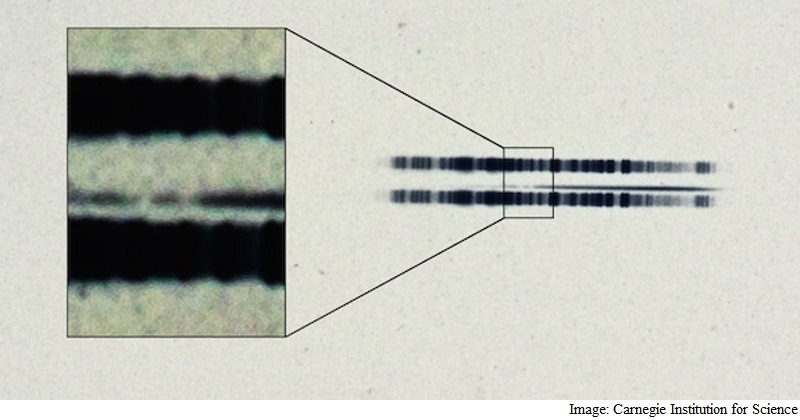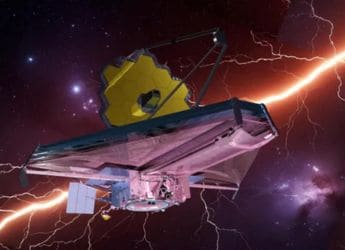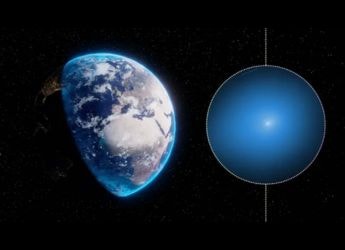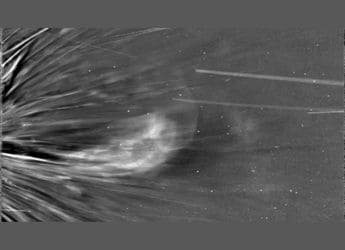- Home
- Science
- Science News
- 1917 Image Reveals First Ever Evidence of Exo Planetary System
1917 Image Reveals First-Ever Evidence of Exo-Planetary System

The unexpected find was recognised in the process of researching an article about planetary systems surrounding white dwarf stars in the journal New Astronomy Reviews.
The Review's author Jay Farihi from University College London and Carnegie Observatories' director John Mulchaey were looking for a plate in the Carnegie archive that contained a spectrum of van Maanen's star.
It is a white dwarf discovered by Dutch-American astronomer Adriaan van Maanen in the very year the plate was made.
Stellar spectra images allowed 19th century astronomers to develop a system for classifying stars that is still used today.
Modern astronomers use digital tools to image stars but for decades, they would use glass photographic plates both to take images of the sky, and to record stellar spectra.
When Farihi examined the spectrum, he found something quite extraordinary.
Carnegie's 1917 spectrum of van Maanen's star revealed the presence of heavier elements such as calcium, magnesium, and iron, which should have long since disappeared into the star's interior due to their weight.
Astronomers now know that that van Maanen's star and other white dwarfs with heavy elements in their spectra represent a type of planetary system featuring vast rings of rocky planetary remnants that deposit debris into the stellar atmosphere.
"The unexpected realisation that this 1917 plate from our archive contains the earliest recorded evidence of a polluted white dwarf system is just incredible," said Mulchaey.
Planets themselves have not yet been detected orbiting van Maanen's star, nor around similar systems, but Farihi is confident it is only a matter of time.
Carnegie has one of the world's largest collections of astronomical plates with an archive that includes about 250,000 plates from three different observatories.
"We have a ton of history sitting in our basement and who knows what other finds we might unearth in the future?" asked Mulchaey.
Get your daily dose of tech news, reviews, and insights, in under 80 characters on Gadgets 360 Turbo. Connect with fellow tech lovers on our Forum. Follow us on X, Facebook, WhatsApp, Threads and Google News for instant updates. Catch all the action on our YouTube channel.
- Samsung Galaxy Unpacked 2025
- ChatGPT
- Redmi Note 14 Pro+
- iPhone 16
- Apple Vision Pro
- Oneplus 12
- OnePlus Nord CE 3 Lite 5G
- iPhone 13
- Xiaomi 14 Pro
- Oppo Find N3
- Tecno Spark Go (2023)
- Realme V30
- Best Phones Under 25000
- Samsung Galaxy S24 Series
- Cryptocurrency
- iQoo 12
- Samsung Galaxy S24 Ultra
- Giottus
- Samsung Galaxy Z Flip 5
- Apple 'Scary Fast'
- Housefull 5
- GoPro Hero 12 Black Review
- Invincible Season 2
- JioGlass
- HD Ready TV
- Laptop Under 50000
- Smartwatch Under 10000
- Latest Mobile Phones
- Compare Phones
- OnePlus 15R
- Realme Narzo 90x 5G
- Realme Narzo 90 5G
- Vivo S50 Pro Mini
- Vivo S50
- OPPO Reno 15c
- Redmi Note 15 5G
- Redmi Note 15 Pro 5G
- Asus ProArt P16
- MacBook Pro 14-inch (M5, 2025)
- OnePlus Pad Go 2
- Poco Pad M1
- Just Corseca Skywatch Pro
- Honor Watch X5
- Acerpure Nitro Z Series 100-inch QLED TV
- Samsung 43 Inch LED Ultra HD (4K) Smart TV (UA43UE81AFULXL)
- Asus ROG Ally
- Nintendo Switch Lite
- Haier 1.6 Ton 5 Star Inverter Split AC (HSU19G-MZAID5BN-INV)
- Haier 1.6 Ton 5 Star Inverter Split AC (HSU19G-MZAIM5BN-INV)












